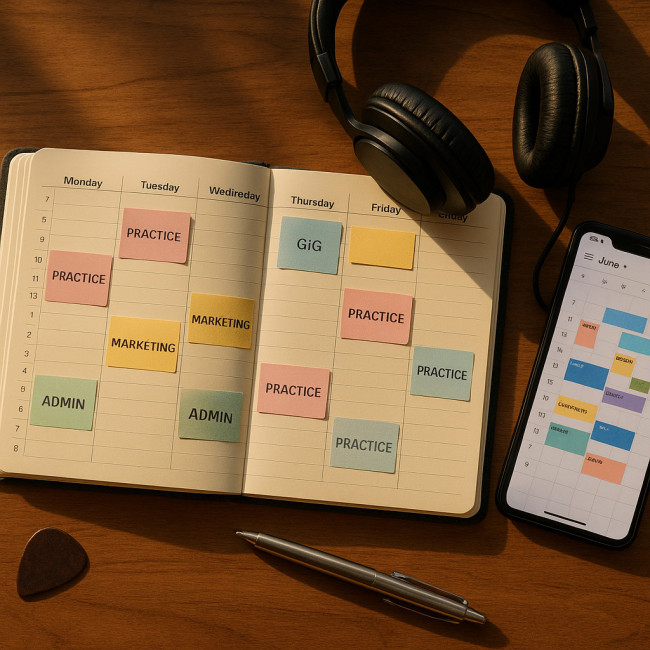Time-blocking methods musicians use to balance gigs, practice and marketing
Torn between rehearsals, evening shows, social-media posts and admin? Time-blocking helps musicians turn scattered to-do lists into a rhythm that protects practice time, secures steady bookings and keeps burnout away. Follow this guide to build a calendar that works like a metronome for your whole career.
Why time-blocking beats multitasking for musicians
Jumping from emails to chord drills drains focus. Research from the American Psychological Association shows task-switching can slash productive time by up to 40 percent. When you group similar tasks into pre-planned blocks, you warm up faster, stay in flow longer and finish earlier—giving you breathing room before the next gig.
Core principles of musician-friendly time-blocking
1. Identify your essential activity buckets
- Performance & rehearsals – sound-checks, set-list reviews, travel, load-ins.
- Technique practice – scales, repertoire maintenance, ear training.
- Creative growth – songwriting, arranging, session collaborations.
- Marketing & networking – content creation, pitching venues, fan engagement.
- Business admin – invoicing, contract review, gear maintenance.
2. Assign realistic weekly hours
Base your blocks on current commitments rather than wishful thinking. If you average three evening shows, rehearsal travel alone may eat six hours.
3. Sync blocks with your energy curve
Many instrumentalists reach technical peak before noon, while vocalists favour midday once the voice is warmed. Align demanding practice blocks with your personal high-energy window.
4. Batch similar tasks
Recording all short rehearsal clips for socials on one afternoon is faster than filming daily snippets. Ditto for emailing promoters—batch them into a single 45-minute slot.
5. Protect your anchor block
Choose one non-negotiable daily block (often technique practice) and treat it like a headline gig. Everything else shifts around it.
Sample weekly schedule for gigging musicians
| Day | Morning | Afternoon | Evening |
|---|---|---|---|
| Mon | Technique practice (2 h) | Marketing content batch (90 min) | Songwriting session |
| Tue | Admin & invoicing (1 h) | Band rehearsal (3 h) | Open mic performance |
| Wed | Technique practice (2 h) | Pitch emails to venues (45 min) | Rest / learning stream |
| Thu | Creative growth (1,5 h) | Social media scheduling (1 h) | Local gig + travel |
| Fri | Technique practice (2 h) | Gear maintenance | Out-of-town show |
| Sat | Recovery & listening | Family / leisure | Festival slot |
| Sun | Weekly review & planning | Collaborative jam | Rest |
Adjust the template around your own booking cycle. Touring heavy? Convert weekday evenings into travel blocks and move marketing to early mornings with hotel Wi-Fi.
Digital tools that keep the groove
Calendar overlays
Google Calendar allows colour-coded calendars for practice, gigs and marketing. Toggle visibility to avoid clashes and export to your phone.
Automated reminders
Use Trello or Notion to trigger reminders 15 minutes before each block, reducing the chance of “just one more YouTube video” overruns.
Time-tracking plugins
RescueTime measures real usage. After a week, compare planned blocks with actual computer activity to tighten your estimates.
Typical challenges—and fast fixes
- Unexpected last-minute gig
- Swap it with a marketing block later in the week and batch social posts using auto-publish tools.
- Creative block during songwriting
- Switch to a low-cognitive task like string changes; return fresh next block.
- Travel overruns eat practice time
- Pack a practice pad, mini-keyboard or ear-training app to convert transit hours into micro-blocks.
Integrate time-blocking with other scheduling tactics

Combine your new system with flexible rehearsal scheduling to keep bandmates aligned, and borrow ideas from season planning for touring artists to scale the method across an entire tour cycle. For safeguarding your hands when blocks get intense, check the daily practice frameworks guide. Finally, once your calendar opens room for international shows, review legal & logistics essentials for festivals abroad so your blocks survive across time zones.
Advanced tips for seasoned pros
- Themed days – Dedicate Mondays to marketing, Tuesdays to teaching, etc. This lowers cognitive switching costs even further.
- 90/20 rehearsal cycles – Practise intensely for 90 minutes, then take a 20 minute break to protect hearing and muscles.
- Buffer blocks – Reserve one empty 30-minute block daily to absorb spill-overs without destroying the schedule.
- Quarterly retrospectives – Every three months, audit which blocks produced the highest artistic or revenue return and reallocate.
Stay inspired
For fresh exercises that fit neatly into practice blocks, explore the musician training section on Artfolio. Curated mini-courses slot perfectly into 30-minute windows.
Time-blocking quick quiz
FAQ
- How many hours should I block daily for technique?
- Two focused hours work for most professionals. Beginners may start with 45-minute blocks twice a day to build stamina.
- What if a block overruns?
- Use buffer blocks or shift a flexible task like social media to the next day. Never steal time from sleep or recovery blocks.
- Can I mix Pomodoro with time-blocking?
- Yes. Break a two-hour practice block into four Pomodoro cycles (25 min work, 5 min rest) to stay sharp.
- Do time-blocking methods suit touring schedules?
- Absolutely. Create a mobile template and adjust local time zones nightly. Include travel, load-in and sound-check as separate blocks.
- Which calendar view is best: daily or weekly?
- Weekly views reveal balance across activity buckets; daily views help execute. Toggle between both for clarity.
Hit the downbeat—your next step
Block one hour today to map your first weekly schedule. Protect your anchor practice time, batch your marketing and watch your gigs, skills and fan base grow in harmony.
Ready to tune your calendar? Grab the sample template above, adapt it to your reality and start seeing measurable progress this week.











